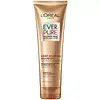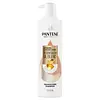What's inside
What's inside
 Key Ingredients
Key Ingredients

No key ingredients
 Benefits
Benefits

 Concerns
Concerns

 Ingredients Side-by-side
Ingredients Side-by-side

Water
Skin ConditioningCoco-Betaine
CleansingDisodium Laureth Sulfosuccinate
CleansingSodium Cocoyl Isethionate
CleansingSodium Lauryl Sulfoacetate
CleansingSodium Lauroyl Sarcosinate
CleansingGlycol Distearate
EmollientSodium Chloride
MaskingDecyl Glucoside
CleansingParfum
MaskingPolyquaternium-10
Amodimethicone
PPG-5-Ceteth-20
EmulsifyingSodium Hydroxide
BufferingCitric Acid
BufferingPEG-55 Propylene Glycol Oleate
Propylene Glycol
HumectantCarbomer
Emulsion StabilisingAcrylates/Beheneth-25 Methacrylate Copolymer
Tocopherol
AntioxidantBenzophenone-4
UV AbsorberBenzoic Acid
MaskingTrideceth-6
EmulsifyingMagnesium Nitrate
Linalool
PerfumingCamelina Sativa Seed Oil
Skin ConditioningSodium Benzoate
MaskingPrunus Armeniaca Kernel Oil
MaskingCetrimonium Chloride
AntimicrobialVitis Vinifera Seed Oil
EmollientCoumarin
PerfumingTetrasodium EDTA
Methylchloroisothiazolinone
PreservativeMagnesium Chloride
Methylisothiazolinone
PreservativeHelianthus Annuus Seed Oil
EmollientRosmarinus Officinalis Extract
AntimicrobialFish Oil
Skin ConditioningWater, Coco-Betaine, Disodium Laureth Sulfosuccinate, Sodium Cocoyl Isethionate, Sodium Lauryl Sulfoacetate, Sodium Lauroyl Sarcosinate, Glycol Distearate, Sodium Chloride, Decyl Glucoside, Parfum, Polyquaternium-10, Amodimethicone, PPG-5-Ceteth-20, Sodium Hydroxide, Citric Acid, PEG-55 Propylene Glycol Oleate, Propylene Glycol, Carbomer, Acrylates/Beheneth-25 Methacrylate Copolymer, Tocopherol, Benzophenone-4, Benzoic Acid, Trideceth-6, Magnesium Nitrate, Linalool, Camelina Sativa Seed Oil, Sodium Benzoate, Prunus Armeniaca Kernel Oil, Cetrimonium Chloride, Vitis Vinifera Seed Oil, Coumarin, Tetrasodium EDTA, Methylchloroisothiazolinone, Magnesium Chloride, Methylisothiazolinone, Helianthus Annuus Seed Oil, Rosmarinus Officinalis Extract, Fish Oil
Water
Skin ConditioningSodium Cocoyl Isethionate
CleansingLauramidopropyl Betaine
CleansingCocamidopropyl Betaine
CleansingSodium Lauroyl Sarcosinate
CleansingParfum
MaskingArgania Spinosa Kernel Oil
EmollientSimmondsia Chinensis Seed Oil
EmollientPanthenol
Skin ConditioningHistidine
HumectantPolyquaternium-10
Dimethiconol
EmollientTea-Dodecylbenzenesulfonate
CleansingLaureth-23
CleansingSodium Citrate
BufferingCitric Acid
BufferingSodium Benzoate
MaskingSodium Salicylate
PreservativeTetrasodium EDTA
Water, Sodium Cocoyl Isethionate, Lauramidopropyl Betaine, Cocamidopropyl Betaine, Sodium Lauroyl Sarcosinate, Parfum, Argania Spinosa Kernel Oil, Simmondsia Chinensis Seed Oil, Panthenol, Histidine, Polyquaternium-10, Dimethiconol, Tea-Dodecylbenzenesulfonate, Laureth-23, Sodium Citrate, Citric Acid, Sodium Benzoate, Sodium Salicylate, Tetrasodium EDTA
Ingredients Explained
These ingredients are found in both products.
Ingredients higher up in an ingredient list are typically present in a larger amount.
Citric Acid is an alpha hydroxy acid (AHA) naturally found in citrus fruits like oranges, lemons, and limes.
Like other AHAs, citric acid can exfoliate skin by breaking down the bonds that hold dead skin cells together. This helps reveal smoother and brighter skin underneath.
However, this exfoliating effect only happens at high concentrations (20%) which can be hard to find in cosmetic products.
Due to this, citric acid is usually included in small amounts as a pH adjuster. This helps keep products slightly more acidic and compatible with skin's natural pH.
In skincare formulas, citric acid can:
While it can provide some skin benefits, research shows lactic acid and glycolic acid are generally more effective and less irritating exfoliants.
Most citric acid used in skincare today is made by fermenting sugars (usually from molasses). This synthetic version is identical to the natural citrus form but easier to stabilize and use in formulations.
Read more about some other popular AHA's here:
Learn more about Citric AcidParfum is a catch-all term for an ingredient or more that is used to give a scent to products.
Also called "fragrance", this ingredient can be a blend of hundreds of chemicals or plant oils. This means every product with "fragrance" or "parfum" in the ingredients list is a different mixture.
For instance, Habanolide is a proprietary trade name for a specific aroma chemical. When used as a fragrance ingredient in cosmetics, most aroma chemicals fall under the broad labeling category of “FRAGRANCE” or “PARFUM” according to EU and US regulations.
The term 'parfum' or 'fragrance' is not regulated in many countries. In many cases, it is up to the brand to define this term.
For instance, many brands choose to label themselves as "fragrance-free" because they are not using synthetic fragrances. However, their products may still contain ingredients such as essential oils that are considered a fragrance by INCI standards.
One example is Calendula flower extract. Calendula is an essential oil that still imparts a scent or 'fragrance'.
Depending on the blend, the ingredients in the mixture can cause allergies and sensitivities on the skin. Some ingredients that are known EU allergens include linalool and citronellol.
Parfum can also be used to mask or cover an unpleasant scent.
The bottom line is: not all fragrances/parfum/ingredients are created equally. If you are worried about fragrances, we recommend taking a closer look at an ingredient. And of course, we always recommend speaking with a professional.
Learn more about ParfumPolyquaternium-10 is an ammonium salt of hydroxyethylcellulose. It is a white and granular powder used as a film-former and anti-static agent.
This ingredient is commonly found in hair conditioning products. According to a manufacturer, its positive charge makes it great for absorbing hair proteins. The manufacturer also states this ingredient helps with curl retention.
For haircare friends: this ingredient is not a silicone.
Learn more about Polyquaternium-10Sodium Benzoate is a preservative. It's used in both cosmetic and food products to inhibit the growth of mold and bacteria. It is typically produced synthetically.
Both the US FDA and EU Health Committee have approved the use of sodium benzoate. In the US, levels of 0.1% (of the total product) are allowed.
Sodium benzoate works as a preservative by inhibiting the growth of bacteria inside of cells. It prevents the cell from fermenting a type of sugar using an enzyme called phosphofructokinase.
It is the salt of benzoic acid. Foods containing sodium benzoate include soda, salad dressings, condiments, fruit juices, wines, and snack foods.
Studies for using ascorbic acid and sodium benzoate in cosmetics are lacking, especially in skincare routines with multiple steps.
We always recommend speaking with a professional, such as a dermatologist, if you have any concerns.
Learn more about Sodium BenzoateSodium cocoyl isethionate is a natural ingredient from coconut oil. It is an ultra gentle cleanser that gives a nice foam without drying the skin or impacting the skin barrier.
The amount of foam created depends on the amount of sodium cocoyl isethionate used in the product.
This ingredient also helps improve the spreadability of a product.
Learn more about Sodium Cocoyl IsethionateSodium Lauroyl Sarcosinate is a cleansing agent and emulsifier. It is a surfactant derived from sarcosine, and a common source is coconut oil.
As a surfactant, Sodium Lauroyl Sarcosinate helps lift dirts, oil, and other molecules to be washed away. In leave-on products, this ingredient is used as an emulsifier. Emulsifier help prevent ingredients such as oils and waters from separating.
Sodium Lauroyl Sarcosinate is also commonly found as a foaming agent in shampoo, toothpaste, and shaving foam. It is amphiphilic, meaning it loves both water and fats.
Learn more about Sodium Lauroyl SarcosinateTetrasodium EDTA is the salt formed from neutralizing ethylenediamine tetraacetic acid with sodium hydroxide. It is a chelating agent and used to prevent metal ions from binding to other ingredients. This helps keep the product and ingredients stable.
Tetrasodium EDTA comes as a white solid and is soluble in water.
Water. It's the most common cosmetic ingredient of all. You'll usually see it at the top of ingredient lists, meaning that it makes up the largest part of the product.
So why is it so popular? Water most often acts as a solvent - this means that it helps dissolve other ingredients into the formulation.
You'll also recognize water as that liquid we all need to stay alive. If you see this, drink a glass of water. Stay hydrated!
Learn more about Water